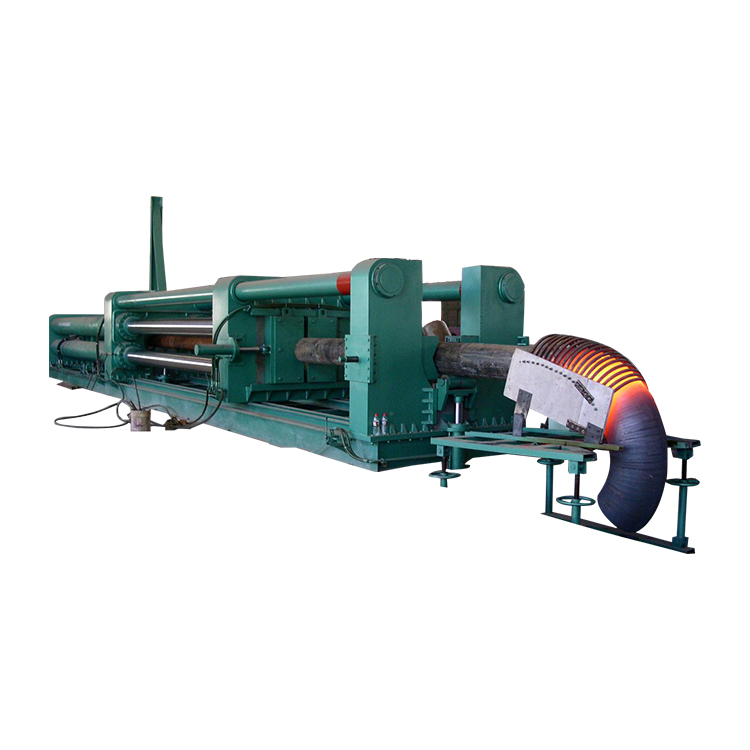Chinese | English
Product Center
HOT FORMING ELBOW MACHINE
medium frequency heat pushing elbow bend machine

Mechanical parameters
Technical parameters(208209)
| Model |
|
|
|
|
|
|
|
| Processing range | 1"~6" | 3"~12" | 8"~24" | 16"~30" | 20"~36" | 30"~48" | 32"~56" |
| Max. wall thickness | Sch40 | ||||||
| Max. pressure | 31.5MPa | ||||||
| Working pressure | 25MPa | ||||||
| Working speed | 0~1000mm/min | ||||||
| Return speed | 1500~2000mm/min | ||||||
| Cylinder diameter | 125mm×2 | 180mm×2 | 300mm×2 | 320mm×2 | 360mm×2 | 280mm×4 | 320mm×4 |
| Cylinder stroke | 3000mm | 4000mm | 5000mm | 5000mm | 6000mm | 8000mm | 10000mm |
| Cylinder thrust | 30T×2 | 30T×2 | 175T×2 | 200T×2 | 250T×2 | 150T×4 | 200T×4 |
| Motor power | 18.5kW | 22.5kW | 37.5kW | 48kW | 56kW | 68kW | 80kW |
| IF power supply needed | 160kW | 250kW | 400kW | 500kW | 600kW | 800kW |
1000kW |
Mechanical video
Equipment details
Intermediate frequency elbow machine
Medium frequency elbow mechanism - heat push forming
Hot push elbow forming process is a process in which the blank on the mould moves forward under the push of the pushing machine by adopting special medium frequency elbow machine, core die and heating device, and is heated, expanded and bent during the movement.Elbow forming heating methods, and which heating method is generally based on the requirements of the product and energy situation.
The deformation characteristics of the medium frequency heat pushing elbow bend machine is, according to the volume before and after plastic deformation rule of metal materials determine the pipe diameter, it USES the pipe diameter less than bend diameter, through the core module and control the deformation of the process, make the inner arc compressed metal flow, the compensation to other parts of the thinned by hole diameter, wall thickness uniform Angle is obtained.The main difference between stainless steel elbow and carbon steel elbow is the different material, its chemical composition will keep the elbow surface for a long time will not rust, will not be corroded.
In piping systems, elbows are pipe fittings that change the direction of the piping.According to the Angle points, there are 45° and 90°180°, the three most commonly used, in addition, according to the engineering needs also include 60° and other abnormal Angle bend.
Elbow press method:
1. The material for hot push, push machine head or is a horn core mandrel, mandrel from fine to coarse, elbow bend machine automatically push system process is a process with a curved hole diameter, back support, under the section through the mandrel, behind a memorial arch frame will be fixed mandrel, one of the car, the car some through hydraulic transmission, some mechanical transmission by screw drive, and then push the car, the car pushes down the mandrel pipe, outside the core rod, induction coil, there is a heat pipe, heat is good, and then push the pipe under the car, good processing a bend.
2. Hardpacking process: after shot peening treatment, the inside and outside surface of the elbow will be removed, and the two ends will be beveled so as to facilitate welding.
3. The automatic elbow machine should select the specifications before pushing the elbow, and put forward the pipe material, such as the elbow of 90 degrees. Through its curvature, it can calculate how long the next material can process the elbow of 90 degrees, and then cut it off with the fixed length
4. Push the system after the completion of the elbow to plastic under thermal state, because of some elbow after improper handling will be distorted, this is not standard non-standard products, in addition push the good elbow are generally large front end diameter, through plastic mould for plastic, plastic mould is press actually, want to have a set of mould, two and a half arc, the upper one, after the plastic outer diameter of the size of the finished product.
Related equipment


